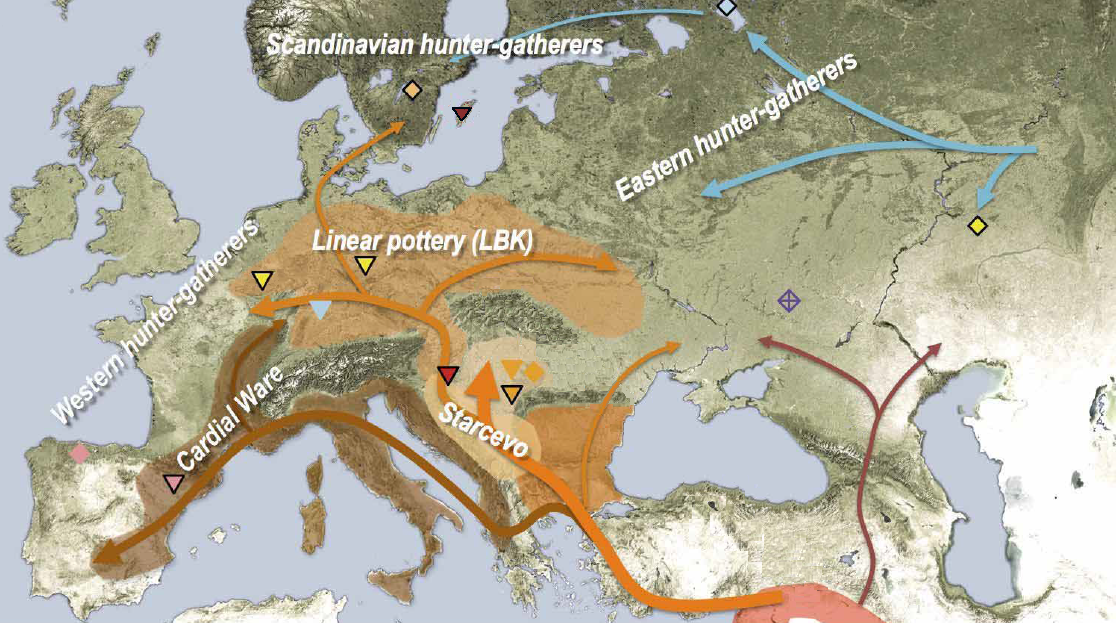
The spread of the European Neolithic
G - PF3147

The G ice mummy

The spread of the European Neolithic |
G - PF3147 |

The G ice mummy |
|
* |
|
* G2a-P15 split somewhere in Southwest Asia round 17.800 years ago, in the late Mesolithic, in Southwest Asia in G2a1-Z5652 and G2a2-L1259. * G2a2 split round 16.800 years ago in the Fertile Crescent in G2a2a-PF3147 and G2a2b-l30, where the two developed the Neolithic agrarian culture. Together they count for round 5% of the European G. G-L30 is ten times more numerous than G-PF3147. In Çatalhöyük in South Anatolia, is found the oldest archaelogical find of G-PF3147, this was G2a2a1a3a-BY133179, dated about 6.730 ybc, so 8.730 years old. Çatalhöyük was first settled around 7100 BCE and there lived more than 10,000 people. (1) 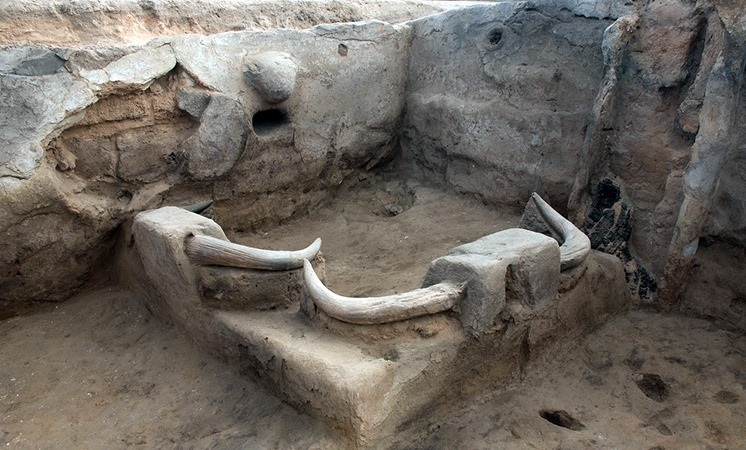
Excavations in Çatalhöyük, Turkey (2) * The next oldest archaelogical comes from at Tepecik Ciftlik. This was a G2a2a2-Z36520 dated to 6635-6475 cal BCE. A spreadsheet with All archaeological G you wil find at: Ancient G-M201s with sequencing. 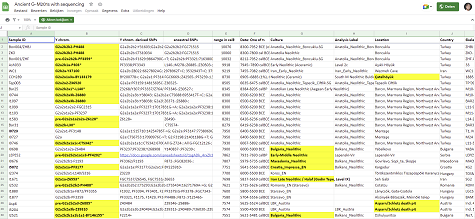
* 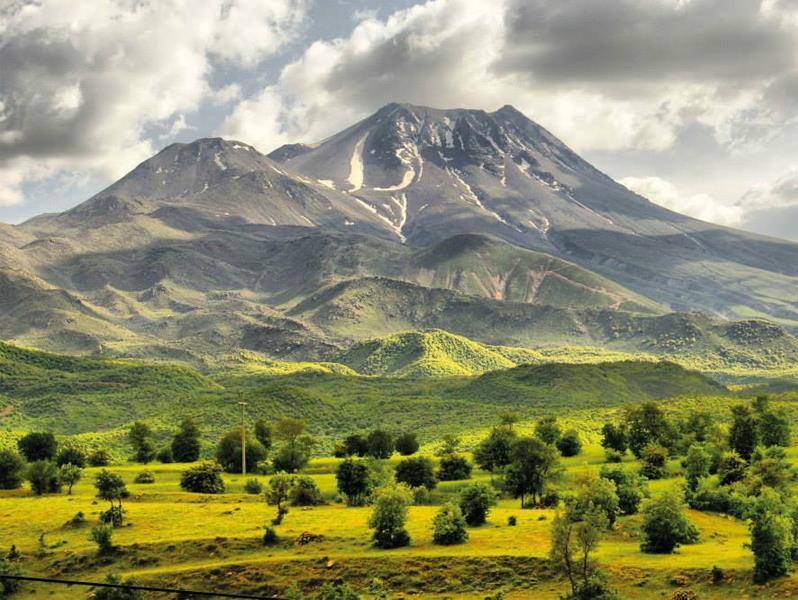
Mount Hasan where the G-PF3147 people of Tepecik-Çiftlik got their obsidian * Leaving the RegionIt has been suggested that leaving the settlements in Anatolia was the result of a climate change that had the multiple negative consequences. First, there was global warming after the last ice age that led to a significant rise in sea level, pushing coastal inhabitants inland. This was exacerbated by the associated breakthrough of the Bosphorus, which greatly increased the level of the Black Sea, where many coastal inhabitants were also driven inland. There was also the the Misox oscillation. For three centuries the region became hotter and drier. Agriculture and livestock declined and as a result the yields of agriculture decreased. The G population left the region, the G-PF3147 people mainly went westward to Europe and also to Egypt, Libya and probably already then to Morocco. And they took with them seed and their livestock. 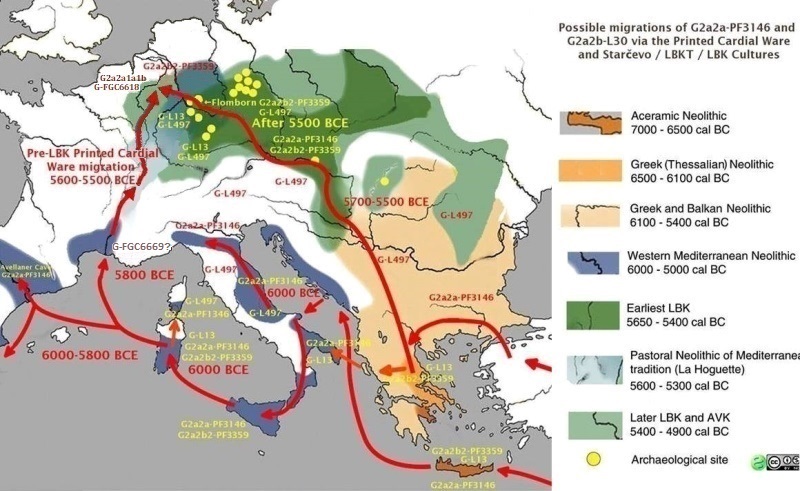
The spread of the Neolithic population across Europe went along two different ways. The Migration to EuropeThe spread of the Neolithic population across Europe went along two different ways. The continentinal group with the Linear Band Culture (LBK) and de maritime group with Cardial Ware culture. The Maritime groupThe Maritime group went from the Aegean maritime region along the coasts of Anatolia and the Levant to Cyprus and Crete. Their pottery is decorated with simple geometric motifs with impressions of various spatulas. It is called Impresso in the Aegean region and in the Levant. In Corfu there came a variation in their pottery, which is called Impressa. It proceeded to dominate. From the west coast of the Balkans, they crossed in 8,200 ybp to Italy. In this phase, their pottery became more diverse and decorated with more complex motifs exclusively applied with the cockle shell, Cardium edule. This is what we call Cardium culture. The expansion continued unabated and thus, approximately 7,500 ybp Portugal was reached via the Spanish coasts There was a leap frogging growth of clusters of residential areas in the Mediterranean coastal plains. Between 7,500 and 7,200 ybp, farmers and hunters lived side by side: The farmers in the plains, the hunters around it in the hills. The hunter's and fishermen's food is half from the sea, that of the farmers is entirely from the built-up land. From Corfu they spread in about seven centuries over a distance of about 4000 km (measured along the coast) at an average speed of 5 km per year or 150 km per generation. They not only colonized the coasts and islands, such as Corsica and Sardinia, but also went inland as far as the Italian Alps. |
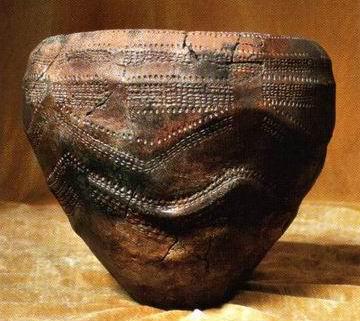
Hoguette culture, 7.000-6.500 ybp, (3) |
A group went north in France along the Rhône and the Loire to the French Atlantic coast.
They arrived in England about 6000 years ago. It is shown that the British Neolithic people derived much of their ancestry from Anatolian farmers who originally followed the Mediterranean route of dispersal and likely entered Britain from north-western mainland Europe. (5) |
The Continental groupThe Continental group went through Macedonia to Serbia and through the valley of the Morava downstream to The Danube and thence through the Danube Valley to Hungary. On the Hungarian lowland, this culture came 8000 years ago. They followed the Danube and came in Germany. An ancient skeleton dated about 7000 years old, G2a2a1-PF3170 and negative for subgroups is found in a man buried in Halberstadt, Germany. 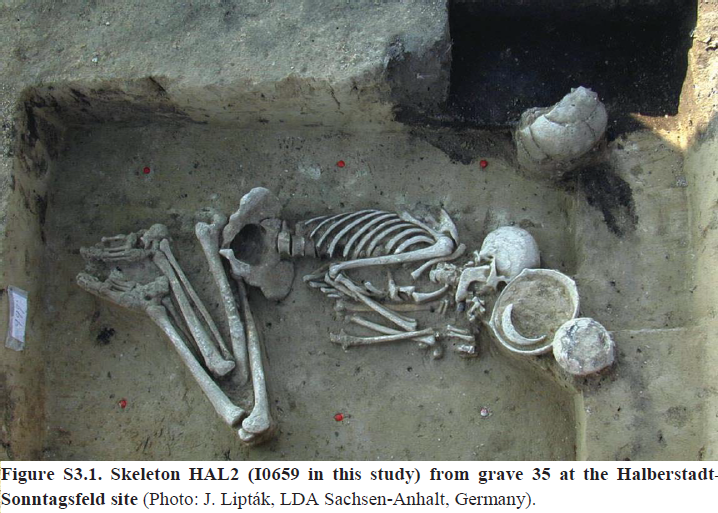
They continued through the Rhine Valley to the Lössgronden of Westphalia and the Southern Netherlands, along Maas and Jeker. In South Limburg, the Hesbaye and Condroz, she were flourishing from 7,300 years ybp. Here they meet the Hoguettiens. Through Lorraine, a branch went along the basin of Paris to the Channel and Hainaut. (6) The culture of these Early Neolithic Farmers is characterized by the cultivation of wheat and barley, and the particular shape of pottery with the characteristic decorations, called the Linear Band ceramic Culture, LBK. They brought with them their cattle, sheep and goats from the Middle East to their new living places. The analysis of the clothing, Alpine Ice mummi Ötzi shows this beautifully. (7) British Neolithic farmers were genetically similar to contemporary populations in continental Europe and in particular to Neolithic Iberians, inhabitants of the east coast of Spain, suggesting that a portion of the farmer ancestry in Britain came from the Mediterranean rather than the Danubian route of farming expansion. (8) With stone chisels and axes with a horizontal blade, the LBK farmers cut down parts of the forest to produce their fields. Here the first wheats as emmer and einkorn was cultivated, and the oilseeds linseed and poppy seeds. This happened especially on the Loess soils, but large parts of the Loess areas in Belgium and South Limburg were deprived of LBK habitation, the northern French area had no occupancy at all during the LBK. Through exchange within a wide network, farmers knew to obtain raw materials from distant regions, such as hematite, an iron oxide that they used to polish pottery and for the red color, and the hard black amphibolite from which they made adzes. 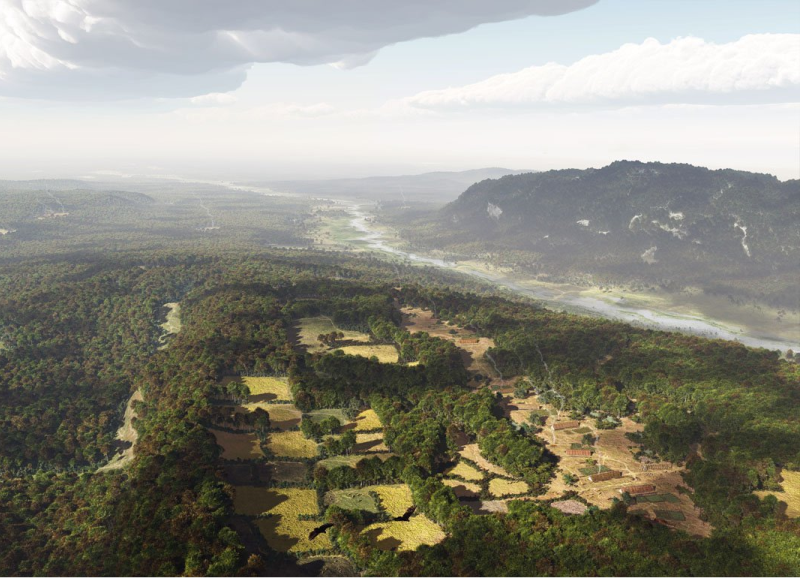
Reconstruction of a LBK village on the Cannerberg at Maastricht. The LBK started in Limburg around 7325 ybp (5,350 BC) and did not last longer than 230 years. Before the year 7,000 ybp it was already over. (9) In a short time the society had changed completely. Settlements arose in the form of several hamlets from three to five houses. These houses had a wooden frame with wattle walls covered with loess, such as in Caberg at Maastricht. The dead were buried in joint cemeteries, some of them were burned others unburned, and they lied close to each other, with gifts in their grave. There was a rapid population growth with the farmers, but with the hunter collectors this is not observed. For Germany a population growth has been calculated from 8000 people at the beginning to 250,000 at the end of the LBK, a growth of 25% per generation. In South Limburg lived in the heyday up to 2000 people. This is as much as the mesolitic population of the whole of the Netherlands. From 7,000 ybp the pottery has different shapes. 1. The famous LBK pottery is quite soft and has open bowls with the typical zigzag straps. 2. The La Hoguette pottery, named after the first location in Normandy, is found across the Rhine and also in our country at Kessel and Sweikhuizen; It is harder and egg-shaped and has a pointed bottom. Until the end, these two cultures flourished side by side. 3. The Limburg pottery group. This can be subdivided into a Rhine-Meuse group and a Seine-Scheldt group and is located as well in the LBK as is La Hoguette area. This pottery are features of the Southern French and Eastern Spanish pottery, a West-Mediterranean background is assumed. (10) 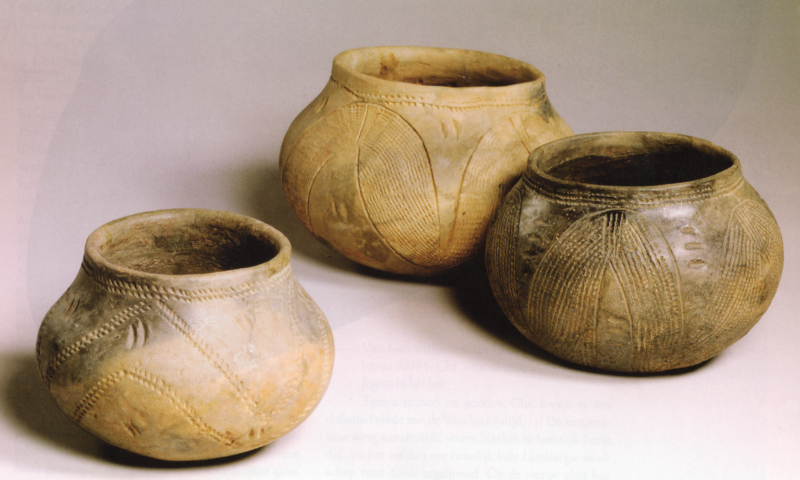
Linear Band Ceramic pottery from Limburg, the National Museum of Antiquities, Leiden, Netherlands The late stages of the Tire Ceramics are characterized in particular in the west by increasing internal violence, most likely between related groups. It seems that robberies developed into a real plague and ultimately led to a disruption of the society through women's robbery, loss of lives, disturbance of harvests or loss of livestock In the Haspengouw and South Limburg the settlements at the end became smaller and then broke down altogether shortly after 7,000 ybp. Then followed a short gap where the old fields were overgrown. It is unclear where the people stayed thereafter. There is no idea about the causes. The society became divided into a number of separate cultural areas, each with their own pottery style, as well as own innovations, such as in the form of axles and housing constructions. Based on the rapid and abrupt changes has been suggested that there was a crisis by internal causes such as soil depletion together with rapid population growth. An argument against this is that the loess soils are very fertile. Due to population growth territorial conflicts may have been a cause. There may have been external causes, for example a serious large-scale epidemic. Or a combination of these. |
|
The agricultural tradition and the wide exchange network for specific commodities was restored not long after the loss of the LBK by farmers of the Rössen culture, 6,500 to 6,000 ybp such as in Maastricht to Randwijk. The Rössen vessels are characteristically decorated with double incisions "goat's foot incision". They are best known for their Breitkeile, massive pole axes of stone, which apparently formed a popular export item. They are found in Southern Germany, far beyond Limburg. This was followed by the Michelsberg culture, 6,400 to 5,500 ybp. It is a collective name of a large number of related communities, known by their Funnel beakers. |
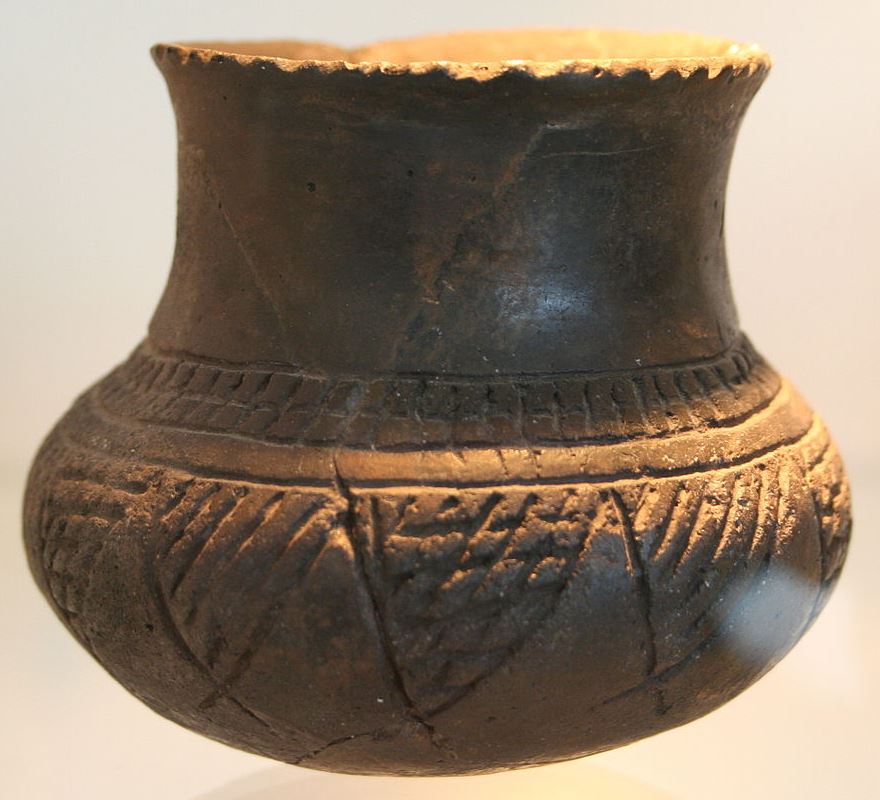
Kugelbecher der Rössener Kultur (11) |
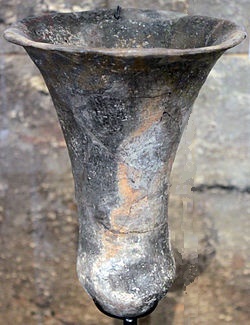
Funnelbeaker |
They lived in the area from southern Scandinavia in the north, the Netherlands to the west, the Danube in the south. In the southeast there was partly an overlap with Lengyel culture. They are the Hunebed builders of Drenthe in the Netherlands. Their residences usually lie on hilltops and have the impression to have been fortified settlements, indicating restless times. Along the Meuse are found hundreds of sites of their pottery and flint remains. Their residences have been simple because we hardly find relics, but they left the first still visible traces in the Limburg landscape in the form of flint mines, such as in Rijckholt-St Geertruid and Valkenburg. The gray flint blocks were collected to a depth of 12 meters from the limestone. With deer horns and flint hoes, operators dug an extensive system of deep mine shafts. |
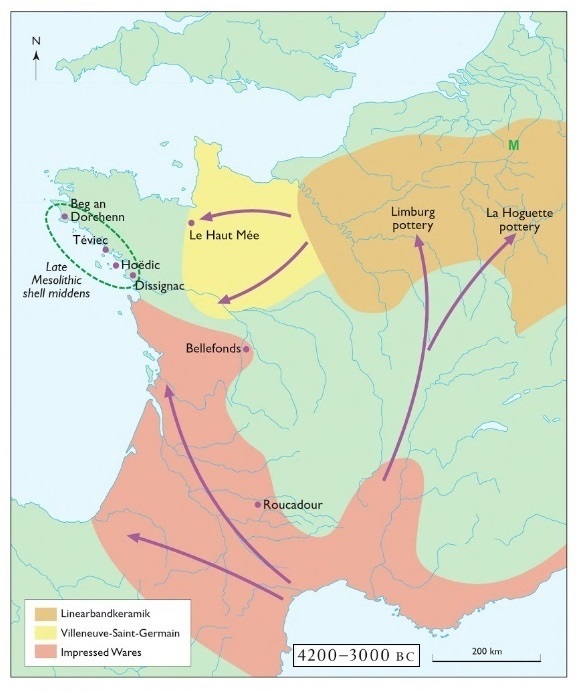
|
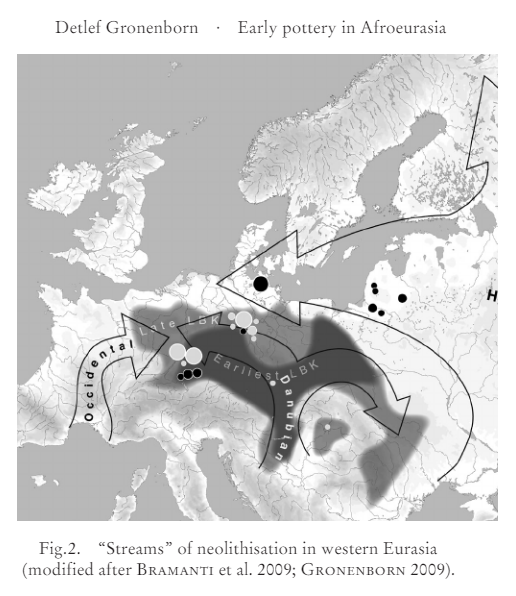
The letter M on the left image indicates the oldest place of residence of the Marres family. This is an edited image from Barry Cunliffe, Britain begins, 2013. |
|
Influences from the Impressed Ware groups of southern France may have filtered northwards to contribute to the Limburg and La Hoguette pottery styles. For a while, late Mesolitic groups maintaned their own life in southern Brittanny. (12) MegalithsConstructions of stone tombs of large stones, megaliths appeared in Europe around 6,800 years ago in the Michelsberger or in the Funnelbeaker culture period. This new culture spread shortly thereafter in three waves from 6,800 to 6,200 years ago from Central Europe to northwestern France and down the Atlantic coast into the Mediterranean, Spain and to Great Britain. (13) SwitserlandMegalithic burials from the end of the Neolithic have been found in Oberbipp and Aesch, Switserland. 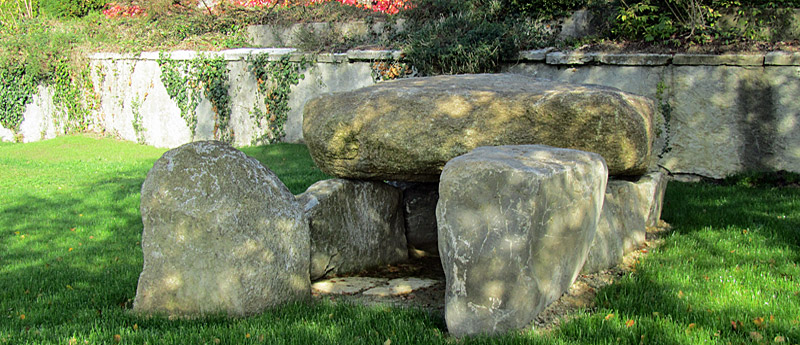
Dolmen Oberbipp, foto Denise Krieg In a dolmen burial in Oberbipp six individuals were G2a2a1a2-L91. Two of them had also G2a2a1a2a-FGC7739 and three were pre-G2a2a1a2a1a-L166*. They are dated between 5300 and 4900 ybp.
RussiaThe dolmens in the Caucasus in Russia are from at least 5250 ybp, placing them roughly in line with tail end of the Neolithic in the western Caucasus and the beginning of the Proto-Colchian culture in the Lowlands. (14a) In a dolmen in the Western Caucasus is found ancient G sample, not sure it was in this dolmen, Dlinnaya I 6272, FGC77440+, a SNP in subgroup G2a2a2a-Z45970. In dolmens of the Western Caucasus bronze knives had been found which have closest analogies in the Mediterranean. (14b) 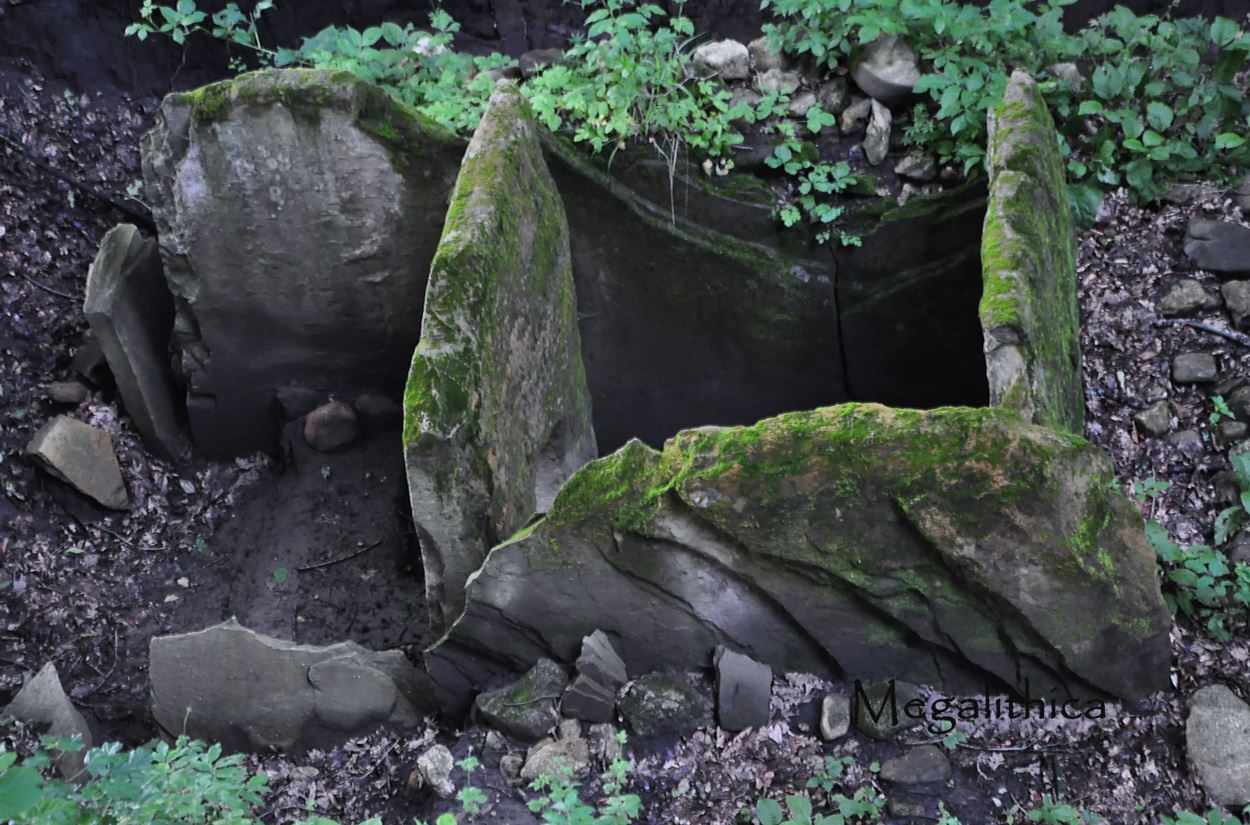
Dolmen in the Western Caucasus NetherlandsThe oldest Dutch dolmen (in Dutch Hunebed) dates back 4,300 years ago. 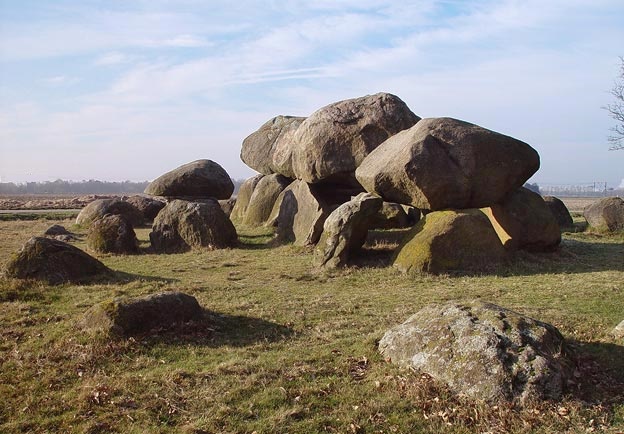
A Dutch Hunebed 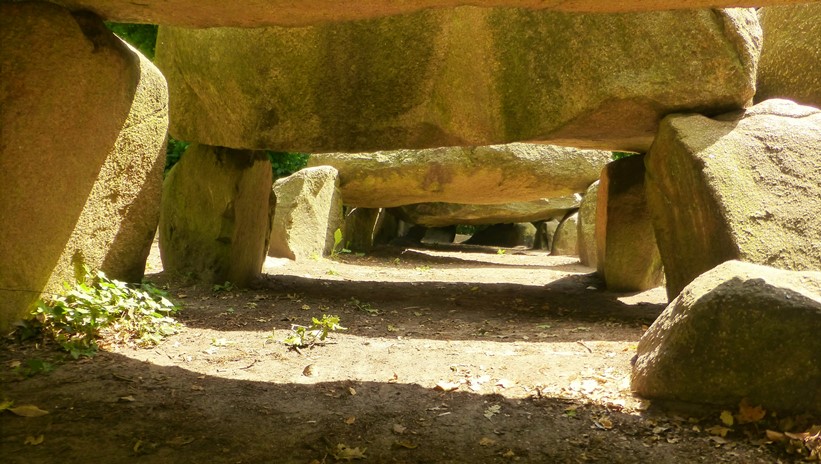
Under a Dutch Hunebed * In England, these Burial Chambers were built for the first time a thousand years later. Sometimes they are arranged in circles; in Wales they are called Cromlech, in England Stone circle and Henge. If they occur in groups, the British call them a Cairn. Selina Brace c.s. found overwhelming support for agriculture being introduced to Britain by incoming continental farmers, with small and genetic affinities with Iberian Neolithic individuals indicating that British Neolithic people were mostly descended from Aegean farmers who followed the Mediterranean route of dispersal. (15) * G2a2a1a3-FGC34725 (FGC34625), is in Archaeological finds from Çatalhöyük, Anatolia, 6825-6635 ybp, in Cueva de los Murciélagos near Cordoba in Castilia, Spain, 7245-7025 ybp, in Malta, 45304400 BP and in Portugal, 3500-2000 ybp and G2a2a1a3a-BY133179 in sixteen graves in twelve different locations in Turkey, Ukraine, Serbia, Malta, Spain and Portugal, dating from 8730 to 4750 ybp. * It is striking that their settlements showed an increase in defensive measures. Notable are the many finds of skeletons that are buried very disorderly, so it seems that that these many people died a violent death. This indicates a violent end of this era. (16) * The Chalcolithic period or Copper AgeThe Carpathians, in the Northern Balkans, are rich in copper. The first copper ore was mined in where now is Serbia and Hungary from 7,400 to 5,800 ybp. The first copper weapons, tools and jewelry were made there. A century later the first gold was melted and processed in present Bulgaria. This was traded over long distances en is found in the former pastoralist societies in the southern Russian steppe and in the cultural flourishing Asia Minor. * Y-DNA in the time of the LBK Culture in EuropeThe Mesolithic European Haplogroups are C, F and I. Some I1, most with haplogroup I1a1-P37, and also I2 lineages of hunter-gatherers assimilated with the Near Eastern farmers who had made their way into Europe across the Balkans and the Mediterranean shores. In the burial grounds in Starvečo and the Hungarian Plane is found the first European G2a with the subgroups G2a2a-PF3147, including G-L91 and G2a2b-L30. Two-thirds had a G clade. (17) Neolithic individuals from Northwest Anatolia from about 8300 years ago show genetically a homogeneous society with a strong resemblance to the first farmers in Europe. They have the same high percentage G2a that in composition is similar to that of the first European farmers, they have a strong genetic (autosomal) relationship. This indicates the now accepted origin of the first European farmers from this area. The European farmers have mixtures with the indigenous European hunter-gatherers. Such a picture we see also in the Anatolians. * Bronze AgeThe Yamnaya Culture on the South Russian SteppesThe steppes of South Russia were inhabited by a distinctive population of hunter-gatherers with high affinity to a 24,000-year-old Siberian. But the step dwellers of that time were descended not only from the preceding eastern European hunter-gatherers, but also from a population of Near Eastern ancestry, although of other origin as in the West. There flourished during 5,600 and 4,300 ybp years ago the Yamnaya Culture. They are said to be the proto Indo-Europeans. They are cattle-breeding nomads and the first users of wheeled vehicles pulled by horses. They buried their dead in pits, sometimes covered with mounds, that shows their social status. They hardened their copper to bronze. They started to melt iron from the rocks forming it into utensils and weapons. * A new population in Europe
|
| Marker | 393 | 19 | 391 | 385a | 385b | 426 | 388 | 439 | 389 I | 392 | 389 II | 458 | 459a | 459b | 447 | 437 | 448 | 449 | GATA H4 | 438 |
| DYS value warrior 1 | 14 | 14-15 | 11 | 13 | 11 | 12 | 11 | 29 | 16 | 9 | 9 | 23 | 16 | 10 | ||||||
| DYS value warrior 2 | 13 | 10 | 15 | 15 | 11 | 12 | 12 | 11 | 29 | 19 | 9 | 9 | 22 | 27 | 12 | 11 |
|
The markers of the 7th century Bavarian cavalrymen. (20) * |
Tree survey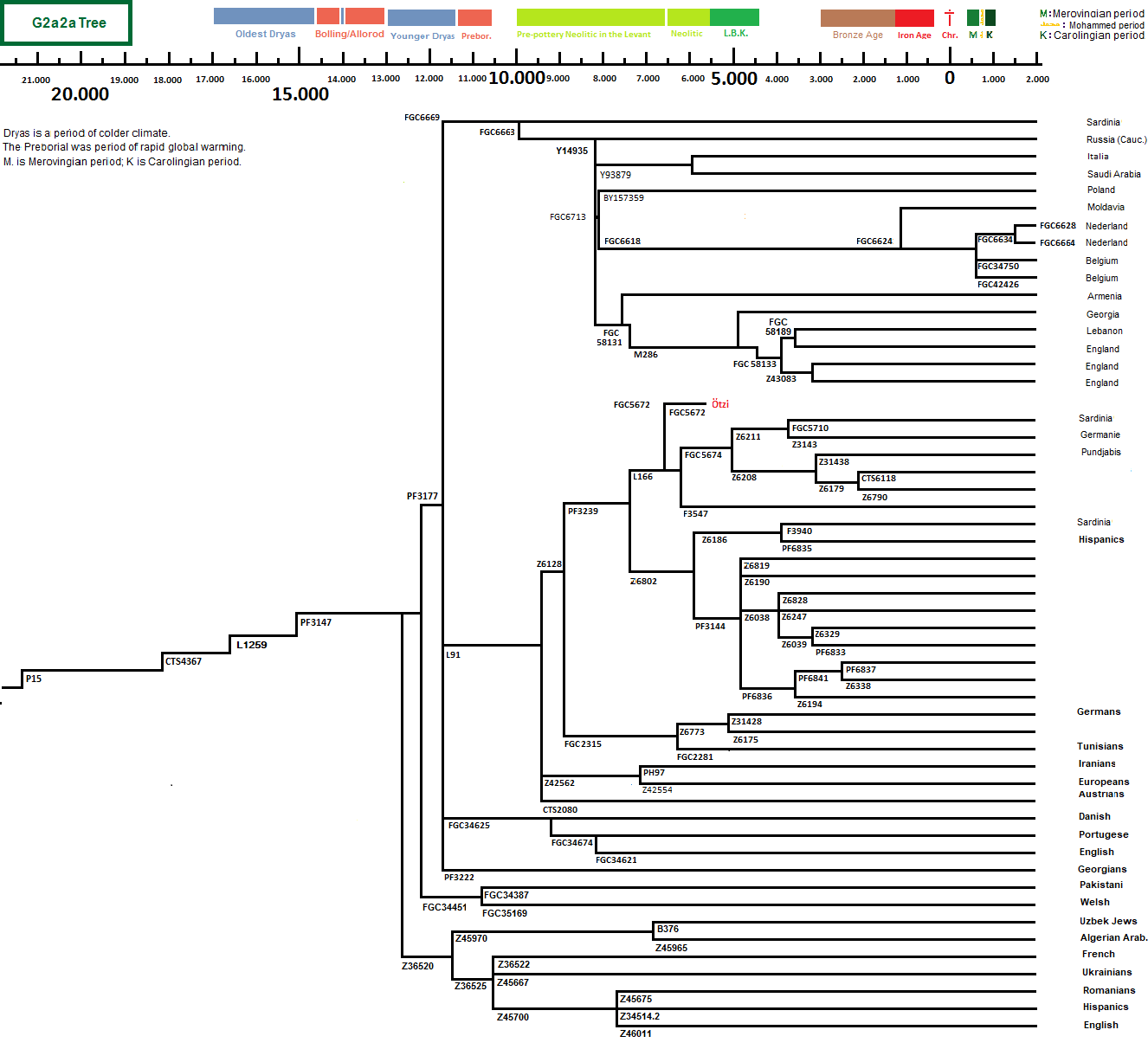
* G2a2a – PF3147The age of this group is 16,000 years old. He divides into five subgroups 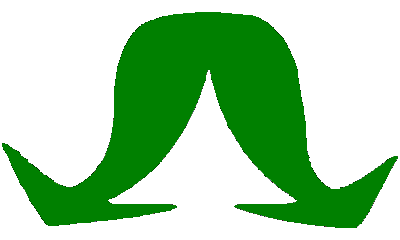
|
|
|
||||||||

|
|
|
|
|
*
G2a2a1a2-L91+This clade arose about 11,000 years ago. In Greece archaelogic finds are in Kleitos dated 6,100 years ago and in Bulgaria 4,759 years ago. L91 clades spread round the Mediterranean region into North Africa, Egypt (now 4%), Libya, Tunisia, the Northern Berbers of Morocco, the Royal family of Morocco, the Alouï, assumed to be descended from Ali ibn Talib, who was the son-in-law and nephew of the prophet Mohammed. Several sultanates, including the current sultans of Perlis in Malaysia, are branches of this lineage. These clade is now also found among the Bakhthiari nomads of Iran and, in Northern India, an Uyghur from China, in Czechia it is 3%. Some in the Netherlands, Germany and in Alsace-Lorraine, He divides into two subgroups: |

|
|
|
*
|
|
|
|
||||||||
|
|
|
Writer: E.C.W.L. (Boed) Marres, Amsterdam |
- Last modification: |